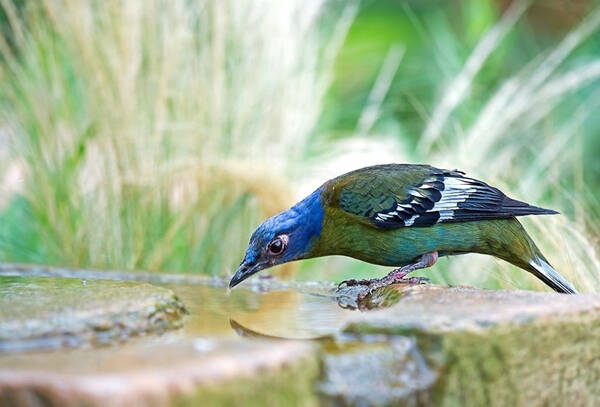Cochoa viridis
IUCN
LCBasic Information
Scientific classification
- name:Cochoa viridis
- Scientific Name:Cochoa viridis,Green Cochoa,Green Thrush,
- Outline:Songbird
- Family:Passeriformes Thrushidae B.Thrush
Vital signs
- length:26-28
- Weight:About 120g
- lifetime:About 10-15 years
Feature
A black and iridescent green thrush-like bird
Distribution and Habitat
Distributed in the Indian subcontinent, including India, Bangladesh, Bhutan, Sikkim, Nepal, Pakistan, Sri Lanka, and the Maldives. Indochina, including Myanmar, Vietnam, Laos, Cambodia, Thailand, and China's southeastern coastal areas.
Distributed in Yunnan (Xishuangbanna) and Fujian (Xiamen) in China.
Mainly inhabits evergreen broad-leaved forests, or appears beside streams, evergreen dense forests, and steep places.
Appearance
Female adult green broad-billed thrush: light diamond blue from the top of the head to the neck; black before the eyes, around the eyes and eyebrow lines; dark blue ear feathers; dark green on the back, wing coverts, waist and tail coverts; flight feathers Black, the middle part of each flight feather is grey-blue, the large coverts and secondary flight feathers are light yellowish brown, the base is brown, the ends of each flight feather are dark brown, forming gray-blue, black and brown wing spots; the tail feathers are blue It is slightly darker than the blue on the top of the head, and the feather tips are black; the chin is light brown; the lower body is green with a slight yellow tint, the belly is green with a slight blue tint, and the lower tail coverts are green with brown. The male bird is similar to the female bird, but the female bird has brown parts and the male bird has blue instead. The iris is black-red, light brown-orange, dark red or chestnut brown, etc., the mouth is
Details
Green Cochoa, also known as Green Cochoa, is a bird of the family Thrushidae in the order Passeriformes, with no subspecies.

The Green Broad-billed Thrush often moves alone or in pairs. During the spring and autumn migration seasons, it also gathers in small groups of several or more than 10 individuals. Sometimes it is also seen forming loose mixed groups with other thrushes. It is mostly active in open areas such as forest edges, wastelands, grass slopes, forest clearings and farmlands. It is a terrestrial thrush that is good at jumping and walking on the ground, and mostly moves and forages on the ground. During the breeding period, it is very good at singing, and its singing is clear and loud, which can be heard from a long distance. It often stays in one place and sings non-stop from morning to night, especially in the early morning and evening. It is active very early every day, sometimes starting to sing around 2:50 in the morning. When singing, it often stands on the branches of small trees under the trees. When it finds people, it immediately flies to the ground and moves forward by jumping rapidly on the ground.
The green broad-billed thrush mainly feeds on insects and insect larvae such as the Coleoptera family, the click beetle family, the burying beetle family, and the Lepidoptera and Diptera. In addition, it also eats other animals such as earthworms and plant fruits and seeds.
The breeding period of the green broad-billed thrush is from May to July, and the earliest one starts breeding at the end of April. The nest is shallow cup-shaped, with a relatively rough and loose structure, mainly composed of moss and grass roots. The nest is mostly placed on small trees under evergreen broad-leaved forests, 1.5-6 meters above the ground, and sometimes nests are built under coniferous forests. Each nest lays 2-4 eggs. The eggs are gray-green with red spots, and the size of the eggs is 27-33 mm × 20-23 mm. The male and female parents take turns to incubate the eggs. The chicks are late-maturing, and the male and female parents raise them together after hatching.
Listed in the 2012 Red List of Endangered Species of the World Conservation Union (IUCN) ver3.1-Least Concern (LC).
Listed in the "National List of Terrestrial Wildlife with Important Economic and Scientific Research Value" issued by the State Forestry Administration of China on August 1, 2000.
Listed in the second level of the "National List of Key Protected Wildlife in China".
Protect wild animals and eliminate game.
Maintaining ecological balance is everyone's responsibility!








